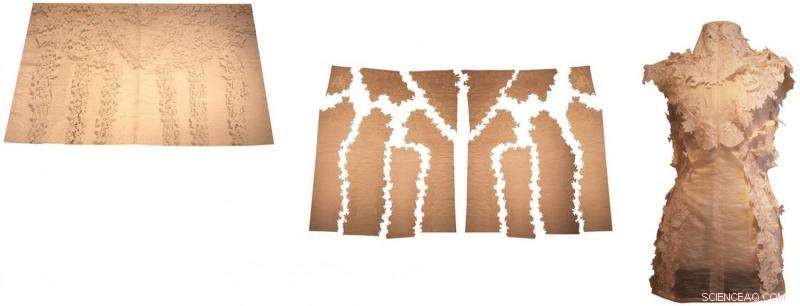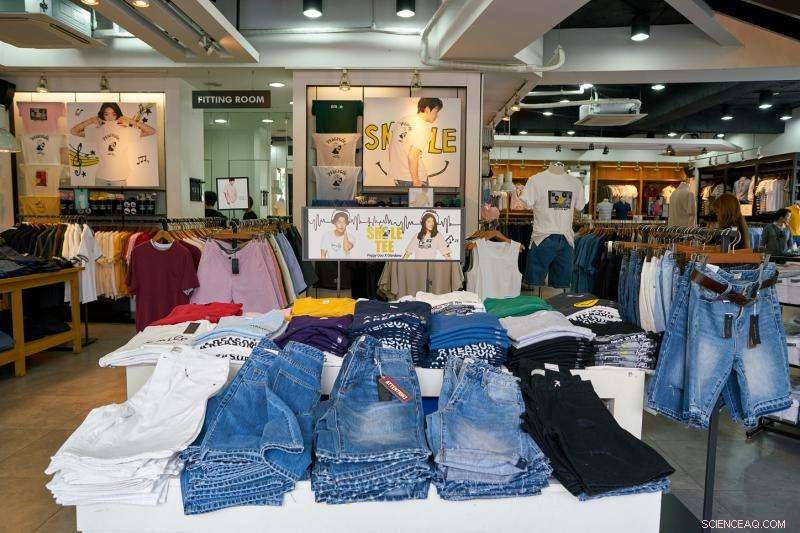
En modell bär en av författarens ursprungliga nollavfallsmönster.
Ökningen av fast fashion i Australien innebär att 6000 kg kläder dumpas på soptippen var tionde minut. ABC:s War On Waste visualiserade denna statistik genom att stapla en gigantisk hög med klädavfall mitt i staden. Så vad ska man göra åt det?
Experter på hållbart mode förespråkar att man avstår från att köpa snabbt mode, marknadsföra klädbyten och reparera gamla kläder. Andra föreslår att man köper ekologiska och etiskt framställda kläder eller designar kläder med tekniker utan avfall. Förhoppningen är att större transparens i leveranskedjorna kommer att leda till ett slut på sweatshops och ohållbara modemetoder.
Det är beundransvärda initiativ, men de minskar bara svinnet eller försenar plaggen från att hamna på soptippen. De tar inte upp det faktum att omfattningen av fast fashion är så massiv att det lätt kan överskugga andra hållbarhetsinitiativ. De tar inte heller upp slöseri med befintlig teknik och det akuta behovet av att forska om nya.
Även om vi magiskt kunde stoppa den globala produktionen av alla plagg, vi skulle fortfarande behöva nya, grön teknik för att sanera det avfall vi redan har skapat. Det finns långsiktiga strategier för grön teknik som elbilar, men var är de stora företagen och forskningsinstituten som utvecklar nästa generations hållbara modeteknologier? Utvecklingen av ny syntetisk biologiteknik kan vara nyckeln.
Från catwalk till forskning
Jag skulle vilja dela med mig av min resa från noll waste modedesignpionjär till transdisciplinär modeforskare för att lyfta fram de utmaningar som hållbart mode står inför och behovet av mer forskning.

En scen från ABC:s War on Waste. Kredit:ABC
Tio år sedan, Jag presenterade min "Zero-Waste" modekollektion på London Fashion Week. Jag och andra hållbara designers på den tiden tog avfallsströmmarna från andra industrier som skrotmaterial och överblivet tyg och skapade våra kollektioner från dem. Jag valdes ut för "Estethica", ett nytt initiativ skapat av hållbara modeguruer Orsola De Castro, Filippo Ricci och Anna Orsini från British Fashion Council. Hållbart mode visades på Londons catwalks bredvid lyxmode – ett revolutionerande steg för tiden.
Jag banade väg för ett sätt att skapa skräddarsydda, high fashion plagg så att alla bitar av ett plagg passade ihop som ett pussel och inget avfall skapades. Konventionell mönsterskärning skapar cirka 15 % slöseri med material, även om mönstret har optimerats av en dator. Jag ville systematiskt förändra hur kläder tillverkades.
Men problemet med zero-waste design är att det är väldigt svårt att skapa. Det kräver en skicklig designer att samtidigt föreställa sig plagget som en 3D-artikel och ett platt mönster, samtidigt som man försöker passa ihop bitarna som en sticksåg. Det är lätt att göra ett otippat eller påsigt plagg, men att skapa något som ser bra ut och passar kroppen var en riktig utmaning.
Även efter alla dessa år, det mesta nutida noll-waste-modet är fortfarande inte anpassat till kroppen. Jag har tränat den här tekniken i flera år för att bemästra den. Det krävde att bryta mot alla regler för konventionell mönstertillverkning och skapa nya tekniker baserade på avancerad matematik.
Det var spännande tider. Våra tyger var ekologiska, vi gjorde allt lokalt och såg till att alla fick en etisk lön. Pressen älskade vår berättelse. Men det började dyka upp problem när det gällde försäljningen. Vi var tvungna att sälja dyrare plagg, använder ett mindre sortiment av tyger - våra material- och arbetskostnader var högre än för företag som producerade utomlands. Modeköpare sa ofta att de älskade det vi gjorde, men efter att ha tittat på prislappen skulle artigt ta sin verksamhet någon annanstans.
Som en hållbar modedesigner, my impact was limited. It was also impossible to teach zero-waste fashion design without explaining how advanced mathematics applied to it. It was time to try a new approach, so I decided to apply science and maths to traditional fashion techniques.

To design a garment with zero waste requires new patternmaking techniques, based on advanced mathematics.
My PhD research explored the underlying geometry of fashion pattern-making. Combining fashion with science allowed the traditional techniques and artistry of making garments to be explained and communicated to scientist and engineers.
Sålänge, fast fashion companies rapidly expanded, with Zara, Topshop and H&M reaching Australia by 2011. They produced massive amounts of cheap products making low margins on each garment. Consumers quickly became addicted to the instant gratification of this retail experience. The size and scale of their production produced hundreds of tonnes of garments every day.
The limits of fashion technology
Fast fashion companies such as H&M have developed recycling initiatives in which consumers can exchange old clothing for discount vouchers. This is supposed to prevent clothing from going to landfill, instead recycling it into new clothing.
Dock, there are those who are sceptical of H&M's recycling process. 2016, investigative journalist Lucy Siegle crunched the numbers and concluded that "it appears it would take 12 years for H&M to use up 1, 000 tons of fashion waste". This, Hon sa, was the amount of clothing they produce in about 48 hours.
A 2016 H&M sustainability report reveals that only 0.7% of their clothes are actually made from recycled or other sustainably-sourced materials. I rapporten, H&M acknowledges :

Consumers have embraced fast fashion. Credit:shutterstock
I dag, this is not possible because the technology for recycling is limited. Av denna anledning, the share of recycled materials in our products is still relatively small.
Faktiskt, their 2016 annual report states that more research is needed:
if a greater proportion of recycled fibres is to be added to the garments without compromising quality, and also to be able to separate fibres contained in mixed materials.
Sustainable technologies strive for a "circular economy", in which materials can be infinitely recycled. Yet this technology is only in its infancy and needs much more research funding. H&M's Global Change Award funds five start-up companies with a total of 1 million Euros for new solutions. Contrast this with the millions required by the most basic Silicon Valley start-ups or billions for major green technology companies such as Tesla or SolarCity. There is a dire need for disruptive new fashion technology.
Many of the promising new technologies require getting bacteria or fungi to grow or biodegrade the fabrics for us - this is a shift to researching the fundamental technologies behind fashion items.
Till exempel, it takes 2700L of water and over 120 days to grow enough cotton to make a T-shirt. Dock, in nature, bacteria such as "acetobacter xylinum" can grow a sheet of cellulose in hours. Clothing grown from bacteria has been pioneered by Dr Suzanne Lee. If a breakthrough can be made so that commercially grown cotton can be grown from bacteria, it may be possible to replace cotton fields with more efficient bacteria vats.
But why just stick with cotton? Fabrics can be generated from milk, seaweed, crab shells, banana waste or coconut waste. Companies such as Ecovate can feed fabric fibres to mushroom spore called mycelium to create bioplastics or biodegradable packaging for companies such as Dell. Adidas has 3-D printed a biodegradable shoe from spider silk developed by AM silk.
Although I began my journey as a fashion designer, a new generation of materials and technologies has pulled me from the catwalk into the science lab. To address these complex issues, collaboration between designers, scientist, engineers and business people has become essential.
To clean up the past and address the waste problems of the future, further investment in fashion technology is urgently needed.
Denna artikel publicerades ursprungligen på The Conversation. Read the original article. 